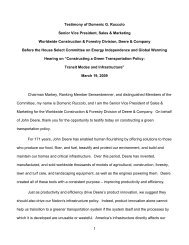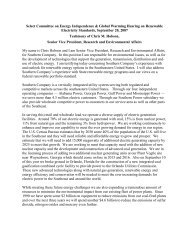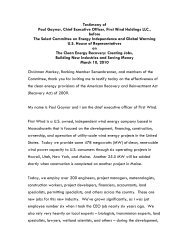Tom Troxel - The Select Committee for Energy Independence and ...
Tom Troxel - The Select Committee for Energy Independence and ...
Tom Troxel - The Select Committee for Energy Independence and ...
You also want an ePaper? Increase the reach of your titles
YUMPU automatically turns print PDFs into web optimized ePapers that Google loves.
larvae experience significant mortality. Similarly, cool moist summers can inhibit beetle activity <strong>and</strong> larval<br />
development <strong>and</strong> increase the effects of fungal pathogens. Under warmer <strong>and</strong> drier climatic conditions,<br />
beetle populations respond with less winter mortality <strong>and</strong> faster, more efficient reproductive cycles.<br />
Under the “average” climatic conditions of the past century, mountain pine beetles exist as an endemic<br />
population within pine <strong>for</strong>ests, colonizing <strong>and</strong> killing trees that are unable or incapable of defending<br />
themselves due to a variety of physiological, genetic or environmental factors. Trees that are not growing<br />
vigorously due to old age, competition, poor growing conditions, drought, fire or other damage are the trees<br />
most likely to be attacked by bark beetles.<br />
<strong>The</strong> availability of suitable host trees is an equally important factor that influences mountain pine beetle<br />
populations. Susceptibility to mountain pine beetles is closely related to tree vigor, which is related to st<strong>and</strong><br />
density. As st<strong>and</strong> density increases, the amount of competition between individual trees within the st<strong>and</strong><br />
<strong>for</strong> water, sunlight <strong>and</strong> nutrients, will also increase. A warmer, drier climate will cause additional stress to<br />
<strong>for</strong>ests, making them even more vulnerable to insect <strong>and</strong> disease outbreaks.<br />
A combination of mild winters, early springs <strong>and</strong> longer summers present perfect conditions <strong>for</strong> mountain<br />
pine beetle survival <strong>and</strong> reproduction. When combined with a l<strong>and</strong>scape dominated by st<strong>and</strong>s of mature<br />
host trees, which are stressed from overstocking <strong>and</strong> drought, the conditions <strong>for</strong> an epidemic are present. If<br />
the climatic conditions that favor bark beetles persist, this epidemic will last as long as there are host trees<br />
available to eat. When epidemic populations develop, trees that originally exhibited resistance to pest<br />
attack can succumb to the sheer numbers of beetles. That is exactly the scenario now playing out in <strong>for</strong>ests<br />
in the Black Hills, Wyoming, Colorado, <strong>and</strong> across the West.<br />
How can <strong>for</strong>estry help produce low carbon energy <strong>and</strong> sequester carbon?<br />
Forestry can help produce low carbon energy <strong>and</strong> sequester carbon through 1) Management Strategies <strong>for</strong><br />
Sequestration, 2) Reducing Fires <strong>and</strong> Insect Epidemics, 3) Substitution of Biomass <strong>for</strong> Fossil Fuels, <strong>and</strong> 4)<br />
Utilization of Wood Products.<br />
3












